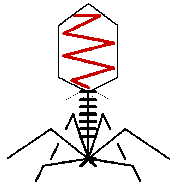
Endonuclease VII
Gp49 is a Nuclease
A brief historical review part II
1981. In a collaborative effort between Kemper's lab in Cologne and groups from the NIH (Bob Weisberg, Kyoshi Mizuuchi and John Hays) proof was presented that endo VII is a Holliday structure resolving enzyme (Mizuuchi et al., 1982). This was the first time that an enzyme with this specificity had been described. From model building it was clear to genetiscists since a long time that such an activity should exist. Robin Holliday, one of the major recombination model builder, had postulated its existence already in 1962 (Holliday, 1962). Holliday structures were finally isolated from VFS-DNA of 49- infections and visualized in the electorn microscope.
1987. Jörg Tomaschewski, a student in W. Rügers lab in Bochum (Germany) isolated gene 49 from phage T4 and cloned it into an over expression vector. The protein was purified to homogeneity in 1990 (Kosak and Kemper, 1990).
1990ff. The specificity of endo VII was tested with numerous DNAs made in vitro by hybridisation of phage DNAs or synthetic oligonucleotides. Endo VII comprised a surprisingly broad substrate profile always cleaving 2-6bp 3' from a target in both strands of a ds-DNA. Targets were, besides Holliday structures, branched DNAs like four-arm structures, three-arm structures, flap-structures and single-strand overhangs. Gaps and nicks in ds-DNAs were also substrates. Furthermore, all mismatches, heteroduplex loops, bulging nucleotides, bulky adducts, AP-sites and kinks in curved DNA were substrates.
1996. The discovery that endo VII reacts with mismatches of all
kinds in ds-DNA, marking them with flanking nicks, made the enzyme a valuable
tool in enzymatic mutation detection technology (EMD). Hybrids between
wildtype and mutant DNAs comprise excellent substrates for endo VII which
can than be used for quickly scanning DNAs for mutations. A patent has
recently been filed.